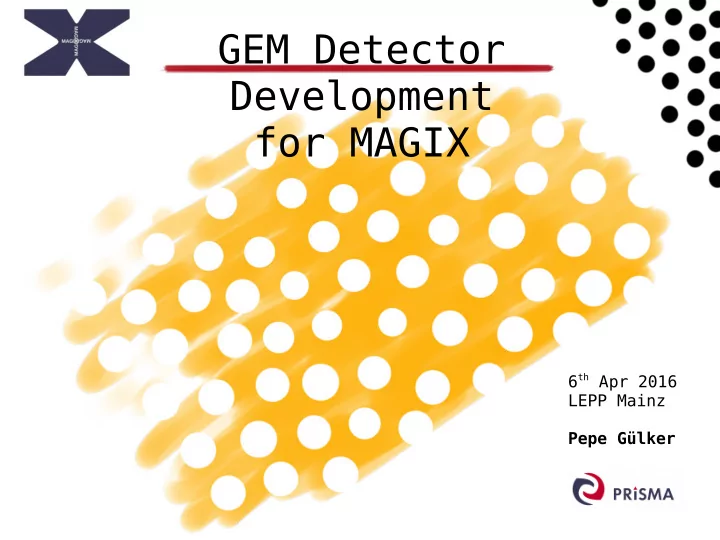

GEM Detector Development for MAGIX 6 th Apr 2016 LEPP Mainz Pepe Gülker 1
Requirements & Challenges for the detector-system ● Spatial Resolution < 50 μm ● Many Channels ~10k ● High Rate Capability ~1MHz (Luminosity: 10 35 cm −2 s −1 ) ● Minimize Material Budget (Energy: < 105 MeV) ● Track Reconstruction ● Large Area 30 x 120 cm 2 2
GEM Gas Electron Multiplier Pitch p = 70 μm Diameter D = 140 μm Copper d Cu = 5 μm Kapton d Ka = 50 μm 3
Requirements & Challenges for the detector-system ● Spatial Resolution < 50 μm → achieved by COMPASS ● Many Channels → APVs ● High Rate Capability ~1MHz → Benlloch et al. ● Minimize Material Budget → Simulation ● Track Reconstruction → Try GEM hodoscope first! 4 ● Large Area 30 x 120 cm 2
Stretching Thermal Stretching Mechanical Stretching ● Tensiometer controlled ● ΔT ~ 80 K ● Used for 10x10 GEMs ● Method for 30x30 GEMs ● Not scalable ● Under development ● Works for mashes as well 5
Profile Measurement ● Take data of foil ● Take data of table ● Correct foil data ● Apply linear and quadratic Fit → Sagging < 100 μm 6
GEM Development ● GEMs trained and ● In house production of stretched readout PCBs ● 10x10 Prototype working ● 16 pad-readout to measure gain uniformity is set up 7
GEM Development 55 Fe Gain Measurement fe55_gainMeas_365 entries: 159593 0.009 1000 Photo Peak (5,89 keV) µ = 388.59 σ = 25.97 0.008 900 Escape Peak (2,70 kev) µ = 169.28 σ = 25.85 0.007 a + b * e^{x/c} 800 Mean of Photo Peak [pC] a = 93.6 +/- 18.5 b = 2.0e-09 +/- 2.6e-09 0.006 700 c = 14.18 +/- 0.68 counts 0.005 600 FWHM 16% 0.004 500 0.003 400 0.002 300 0.001 200 0.000 360 365 370 375 100 200 300 400 500 600 700 800 900 U GEM [V] charge [pC] 55 Fe-Spectra taken with QDC Vary U GEM ● Single channel readout PCB ● Fit charge of photo and ● Built PreAmp for GEMs escape peak for different ● Self triggered via LE- voltages discriminator ● Plot and fit with exp- 8 function
Ongoing 9
Material Budget GEM Cu Foil GEM Cu Readout Readout PCB 100 μm GEM Kapton Kapton u C GEM Kapton t u o d a e Readout Cu R 0.38% X 0 u C Default triple GEM detector m s μ M 0.96% X 0 E 1 G GEM Cu GEM Kapton u C 0.22% X 0 t u o d a e R 10
Laser Calibration UV-Laser 2 Cathode 1 GEM II GEM I Readout Side (1) Diploma Thesis: Mirco Christmann W Cu = 4,4 eV > W Al = 4,1 eV Set up detector prototype Illuminate Al-dots on Cu-cathode (10x10) with multi channel with UV light to extract readout. electrons on fixed grid. (T2K- Method) Perform conventional calibration Top (2) with MICROMEGAS-Hodoscope. Use a movable UV-Laser to create electrons on the bottom side of Proof of concept for the laser 11 a thin aluminized Mylar cathode. calibration setup.
Beam Times 12
Summary ● GEM Tracker for focal plane ● Infrastructure for GEM development set up ● First prototype operational next steps: ● Going bigger ● Going thinner 13
Thank you magix.kph.uni-mainz.de 14
Backup 15
MESA - MAGIX Mode: EB P2 User: P2 Current: 150 μA Energy: 155 MeV Circulations: 6 MESA MX Mode: ERL User: MAGIX Current: 10 mA Energy: 105 MeV Circulations: 4 16
Spectrometers GEM Tracker Focale plane Particle path Target The particle paths are bended 10 35 cm −2 s −1 Luminosity: inside the magnet spectrometers rel. Momentum Res: < 10 -4 in such a way that momenta and Angular Res: < 0,9 mrad scattering angles are mapped to points in the focal plane, which are measured by GEM detectors. 17
Readout PCB Design Readout PCB Minimize Material Budget ● different pitches ● Use Kapton based readout ● pads and stripes foil ● angle between coordinates → FlexPCB ● hex pads? ● Use Electroplating → Peter Bernhard ● Think about Connectors 18
Multi Channel Readout ● INFN Readout System ● APV25 ● 128 Channels per FrontEndCard ● 40 MHz ● Full Wavaform of each Channel ● Panasonic Connectors P5KS are deprecated... 19
Recommend
More recommend